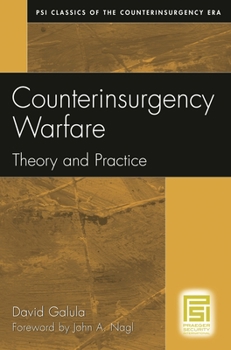Counterinsurgency Warfare: Theory and Practice
Select Format
Select Condition 
Book Overview
This volume in the Praeger Security International (PSI) series Classics of the Counterinsurgency Era defines the laws of insurgency and outlines the strategy and tactics to combat such threats. Drawn from the observations of a French officer, David Galula, who witnessed guerrilla warfare on three continents, the book remains relevant today as American policymakers, military analysts, and members of the public look to the counterinsurgency era of the 1960s for lessons to apply to the current situation in Iraq and Afghanistan. With a new foreword by John A. Nagl, author of Counterinsurgency Lessons from Malaya and Vietnam (Praeger, 2002).
Format:Paperback
Language:English
ISBN:0275993035
ISBN13:9780275993030
Release Date:August 2006
Publisher:ABC-Clio, LLC
Length:128 Pages
Weight:0.51 lbs.
Dimensions:0.4" x 6.1" x 9.2"
Customer Reviews
4 ratings
Modern day classic ...
Published by Thriftbooks.com User , 18 years ago
David Galula's Counterinsurgency Warfare: Theory & Practice is a classic. It is a classic in the sense that it is ... a work of enduring excellence ...an authoritative source [Webster's Ninth New Collegiate Dictionary]. I recommend this volume because it makes better sense of other books on intelligence and special operations, by serving as a metric for both policy and operational analysis. Written almost as a `good news/bad news' aphorism, Galula concedes ..."Very little is offered beyond formulas - which are sound as far as they go - such as, `Intelligence is the key to the problem,' or `The support of the population must be won." P xii. The essence of the text is clearly stated ..."to define the laws of counterrevolutionary warfare, to deduce from them its principles, and to outline the corresponding strategy and tactics." P xiii. Galula begins by defining insurgency as ..."a protracted struggle conducted methodically, step by step, in order to attain specific intermediate objectives leading finally to the overthrow of the existing order ...it can no more be predicted than a revolution; its beginnings are so vague that to determine exactly when an insurgency starts is a difficult legal, political, and historical problem." P 5. Vital decisions depend on the quality of the intelligence available to policy makers. Additionally, and possibly more importantly, intelligence must be evaluated and presented in terms of a practical application. Galula delivers on his promise, as Counterinsurgency Warfare systematically examines the theoretical i.e., strategic aspect of intelligence in terms of practical/tactical i.e., operational applications.
Never Has a Book Been More Relevant in Our Time
Published by Thriftbooks.com User , 18 years ago
Counterinsurgency Warfare: Theory and Practice is perhaps the best textbook on how to fight a guerilla war (to read about how to conduct a guerilla war read Mao Zedong's On Guerilla War or Alberto Bayo's 150 Questions for a Guerilla). David Galua wrote this book. He was a French military officer whose experience in Algeria (during its war of independence from 1954 to 1962) has shaped his views on how to fight an insurgency. As a result, he has written a book that is credible, effective, and given today's current events, very relevant. This book serves as an effective teaching tool for anyone interested in understanding how guerilla war (including terrorism) can be subdued. It short, well written, and presented in a format that is easy for anyone to understand. This contrasts greatly with current military literature of today (including the upcoming US Army's FM 3-24, Counterinsurgency Operations which is, in my view, too big for a busy officer to read in a single day). This book, along with Roger Trinquier's, Modern Warfare, should be included as part of every military officer's recommended reading list. Not only is this book thought provoking (i.e. in providing strategies in fighting insurgents), it is also relevant to our current struggle against international terrorism. This book should be treated as an important weapon in any warrior's arsenal.
40 Years Old and Still the Best
Published by Thriftbooks.com User , 18 years ago
First published in 1964, this is still the best book on the subject. Not as well known as it's more famous companion: "Defeating Communist Insurgency" by Thompson, it addresses the same isues, but is much more applicable to today's conflict. If you are too busy to read it, then go right to page 51, and see how Galula learned to deal with prisoners from his time spent as a prisoner of Mao's forces in China. If some one at the Pentagon had read this, the world would never have heard of Abu Garaib. In a page and a half, Galula told us how to win the war, or, at least not to lose it. Not as "harshly to the point" as McCuen's "The Art of Counter-Revolutionary War", it is the right book at the right time. Agree with previous reviewer, try to get your hands on the Hailer Publishing softcover version as it fits right in the cargo pocket.
Clear, insightful and relevant today.
Published by Thriftbooks.com User , 19 years ago
This is a foundational work on the development of "Counterinsurgency Warfare," and relevant to Iraq, Afghanistan and other hotspots. Galula articulated clearly the how "Revolutionary Warfare" is asymmetric between belligerents, contrary to the balanced warfare between conventional field armies. He is masterful at describing the insurgent dynamics, and gives great insights for conducting Counterinsurgency Operations. The work primarily focuses on anti-colonial revolutions and Marxist-communist insurgencies, but falls short in addressing the fundamentalist religious based insurgency/terrorism, which was very much ongoing (Algeria) during his contemporary times. Very clear and illuminating, and a must for the student of low-intensity conflicts.






